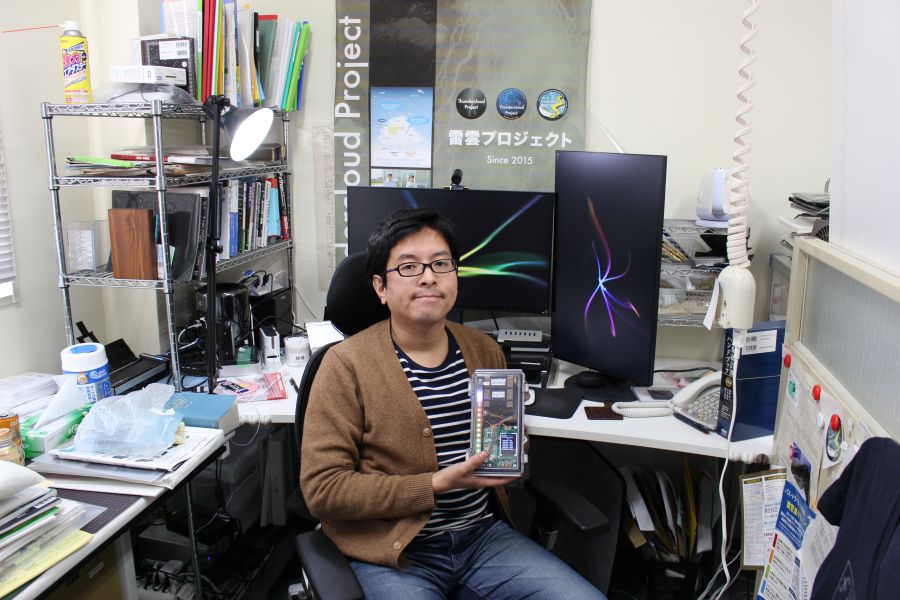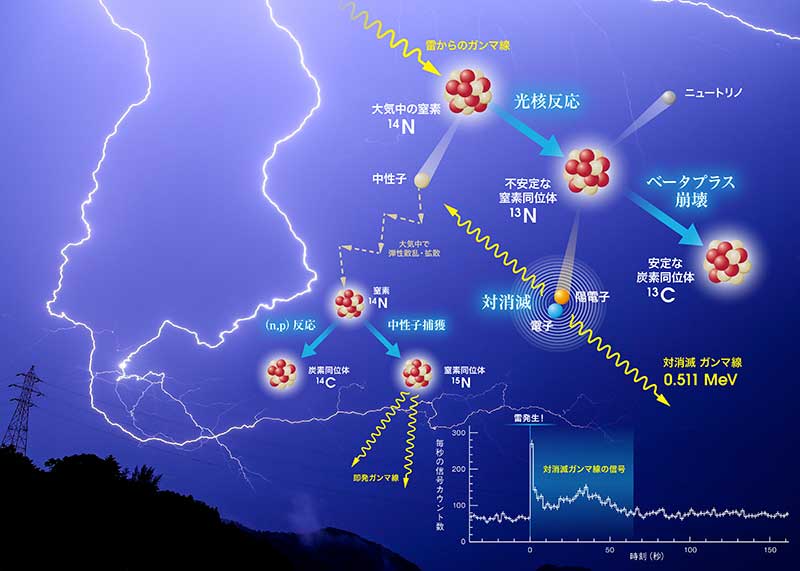
Associate Professor Teruaki Enoto
The Hakubi Center for Advanced Research and Department of Astronomy
Through the ages, people have always been fascinated by lightning. However, it was only in the mid-18th century that the link between lightning and electricity was established. Back in 1752, Benjamin Franklin performed an incredibly dangerous kite experiment to show that lightning is a form of electricity. He actually flew a kite with a key attached in an electrical thunderstorm. The key drew off electricity from the thunderclouds, and he could feel a shock from the key!
Thus, lightning is one of the oldest observed natural phenomena on earth. According to a long-held basic theory, lightning is produced in thunderstorms when hail and water droplets above the freezing level collide, and build up large electrical fields. However, decades of electric field measurements inside thunderstorms have failed to find large enough electric fields to cause a spark. The exact mechanisms of thundercloud electrification and discharge remain elusive.
Nowadays, scientists say that these discharges of a billion volts could be caused by the interaction of cosmic rays—high-energy particles travelling from distant space—with electric fields in thunderclouds.
When cosmic rays enter the Earth's atmosphere they collide with the nuclei of atoms in the air, and strip off electrons. And when this shower of cosmic rays coincides with thunderstorms, the electric field accelerates those electrons almost to the speed of light, boosting them to very high energies, which then make up a naturally-occurring particle accelerators. Then the electrons collide with atoms in the air, releasing even more electrons as well as gamma rays. In fact, these gamma rays have been detected in recent decades by ground-based radiation monitors associated with passage of thunderstorms. Some scientists have been suspecting that these high-energy electrons would become the seed of lightning.
Another related mysterious phenomenon is the Terrestrial Gamma-ray Flash (TGF), which is millisecond bright gamma-ray bursts observed by astronomical satellites. Since the TGF is detected associated with lightning discharges occurring below the satellites, the electron acceleration of thunderstorm activities is believed to be the origin of this phenomenon. The gamma rays of TGFs are so energetic and so bright that nuclear reactions, the interaction between gamma rays and nuclei, have been theoretically expected. Thus, it had been hypothesized that discharges of lightning could induce nuclear reactions in thunderclouds. But because thunderclouds and lightning are unpredictable and hard to pin down, no one had been able to prove this theory. In February 2017, in a collaborative research with other Japanese institutions, Associate Professor Teruaki Enoto of Kyoto University detected evidence to support this idea――signals of neutron and positron after lightning. This is the first conclusive detection of photonuclear reactions triggered by lightning.

Next generation radiation detector developed by Dr Enoto’s team collaborating with a private company TAC Inc., at Kyoto.
The research team, focusing on the gamma ray emissions from lightning and thunderstorms, developed and started installing small-sized radiation detectors in 2015 at several places along the coast of the Sea of Japan for on-ground multipoint radiation measurement. Then in February 2017, four detectors installed in Kashiwazaki, Niigata recorded a strong gamma-ray immediately after a lightning strike a few hundred meters away. From the measurement data, they confirmed three distinct gamma-ray bursts. As a result of careful analysis and calculations, they have succeeded in deciphering origins of all the three successive emissions.

A Kyoto University-based team has unraveled the mystery of gamma-ray emission cascades caused by lightning strikes. (Kyoto University/GROWTH collaboration)
The first burst was caused by the lightning itself. While this gamma-ray emission in lightning had enough energy to knock a neutron out of atmospheric nitrogen (photonuclear reaction), the neutron was subsequently reabsorbed by other atmospheric particles, which as a result produced the gamma-ray afterglow. The final, prolonged emission was the result of unstable nitrogen atoms decaying into other stable isotopes.
With regard to the third emission, which recorded about 0.511 megaelectronvolts, they concluded that as the unstable nitrogen decayed into other stable isotopes, it released positrons that then collided with electrons, causing matter-antimatter annihilations that released more gamma rays.
For the first time in the world, they have successfully explained how gamma rays from lightning react with the air to produce radioisotopes and even positrons -- the antimatter equivalent of electrons.
Dr Enoto’s research has been chosen by Physics World magazine as one of the top ten physics breakthroughs of the year for 2017.
Now, his team aims at establishing a new interdisciplinary research field of “high-energy atmospheric physics of thundercloud and lightening” in collaboration with scientists in other fields. There are many researchers working to untangle the mysteries of thunderstorms by using different techniques such as atmospheric electricity or radar observation as well as meteorological simulation. Through collaborations across fields and combining various techniques, they are trying to uncover the full mechanisms of this beautiful but deadly natural phenomenon.
Paper Information
【DOI】https://doi.org/10.1038/nature24630
Teruaki Enoto, Yuuki Wada, Yoshihiro Furuta, Kazuhiro Nakazawa, Takayuki Yuasa, Kazufumi Okuda, Kazuo Makishima, Mitsuteru Sato, Yousuke Sato, Toshio Nakano, Daigo Umemoto & Harufumi Tsuchiya (2017). Photonuclear reactions triggered by lightning discharge. Nature, 551, 481–484.



